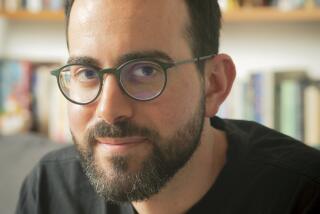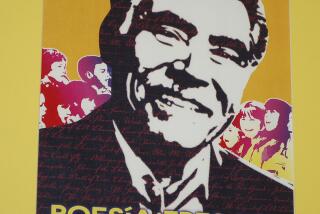‘Not Art: A Novel’ by Péter Esterházy
- Share via
Not Art
A Novel
Péter Esterházy
Translated from the Hungarian by Judith Sollosy
Ecco: 226 pp., $14.99 paper
It’s not every day you find a novel about a mother-son relationship conducted through the language of football (since this is Hungary, what they call football we call soccer). With a writer as caught up in the power and complexity of language as Péter Esterházy, this only enhances his point. For all writers, language is certainly a means to an end, but there are not many who are such word wizards as Esterházy, who has made this short but intense work sparkle with wit and insight:
“My Mother in Front of Her Heavenly Referee (Fiction): My mother would be standing there, between two curlicue clouds, like the English queen between her beehives, shifting her ground, glancing about her, and there’d be a light friendly game in progress between the angels and the novelists, let’s say. Which smells to me like the game’s been fixed of course. . . . “
Of course, there’s a lot going on here behind the curtain of football. “Not Art” expresses itself through an extended football metaphor, but it sweeps wide through national and continental culture and burrows deep into the author’s psyche (and, of course, his mother’s).
Esterházy belongs to a distinguished Hungarian family, and to say that he is steeped in his nation’s essence would be an understatement, for in many ways Hungary in all its glory is a third protagonist of this novel. Consider this encounter between his mother and God:
“[A]t that juncture the Lord, they haven’t even been formally introduced, they haven’t even exchanged greetings yet, shoots my mother a questioning look, the Lord’s a pro at this, this questioning look, in short, was that an offside or my backside, nagyságos asszonyom? (Which audaciously assumes that the Lord is Hungarian. But why shouldn’t the Lord be Hungarian when all the atomic physicists are? Or else He’s not Hungarian just speaks Hungarian? . . . It’s possible that He spoke Hungarian only with my mother, as a sign of His respect.)”
It’s pretty clear who is tops in Esterházy’s worldview here, or is it? Hungary? His mother? Football? What is absolutely apparent is his linguistic gusto, his exuberance, his sheer joy in using language to achieve his purpose. What he writes at one point about his mother applies equally to himself: “She translated my triumphs into the language of football, so she could feel their weight.” Yet Esterházy is able to render profundities without their ever seeming heavy. There is never a leaden moment in this novel, which resembles quicksilver in its mercurial liquidity as it flows on, lighting up his distinctive universe.
For Esterházy’s real achievement in this brief novel is to use the language of football to produce a work that truly contains multitudes. Despite its title, if this novel is anything, it is definitely art, replete with all the requisite qualities: artfulness, artistry and a necessary artifice superbly grounded in existential reality.
Rubin is a critic and the author of “Sara Gertrude Millin: A South African Life.”
More to Read
The biggest entertainment stories
Get our big stories about Hollywood, film, television, music, arts, culture and more right in your inbox as soon as they publish.
You may occasionally receive promotional content from the Los Angeles Times.










